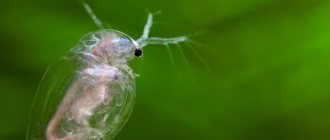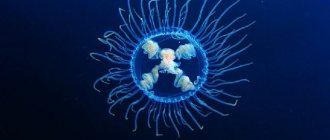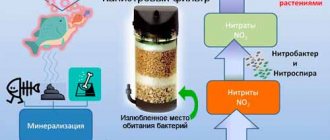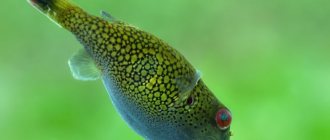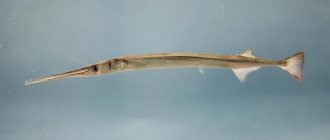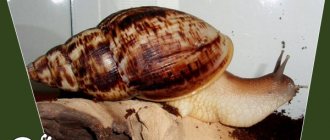Hydra is a soft-bodied polyp from Cnidaria, one of the oldest groups of animals in terms of evolution, which includes corals, jellyfish, hydras and mycozoans. The hydra has a tubular body with a sticky foot at one end and a dozen tentacles at the other. Like the jellyfish, these tentacles have stinging cells that allow the hydra to immobilize its prey. They primarily feed on small aquatic organisms such as cyclops, daphnia and other aquatic crustaceans, but may catch and swallow small fish.
Hydras are sometimes accidentally introduced into freshwater aquariums when plants are added. Hydra does not have a brain, circulatory or respiratory system, or even muscles, but it poses a real danger to small freshwater aquarium fish.
Bryozoans (Bryozoa) in an aquarium
Bryozoans (Bryozoa) in an aquarium photo
These creatures are very similar to tentacles, the size of Bryozoans is from 1 to 3 mm, they grow in a colony, which is why they are very similar to coral, viewers of the movie Avatar saw white creatures similar to bryozoans
Is it necessary to fight bryozoans? In answering this question, the opinions of aquarists differ; on the one hand, they eat ciliates and bacteria, this is useful, which means that bryozoans are helpers and there is no need to fight. But we must be careful that they do not accidentally colonize the filter sponges and begin to feed on nitrifying bacteria. If there are too many bryozoans, more frequent water changes and cleaning the aquarium will help.
Regeneration and growth
The cells of a freshwater polyp are in the process of constant renewal. In the middle of the body they divide, and then move to the tentacles and sole, where they die. If there are too many dividing cells, they move to the lower region of the body.
This animal has an amazing ability to regenerate. If you cut his torso crosswise, each part will be restored to its previous appearance.
The cells of a freshwater polyp are in the process of constant renewal.
Main symptoms
It is not difficult to establish the appearance of xenococcus. It appears as green dots that spread across the main elements of the tank, decorations, snags and plants. If measures are not taken, algae grows uncontrollably and spreads. Xenococus never affects fast-growing plants or algae with long stems. After all, its growth rate is minimal. Those types of shady plants that grow slowly become covered with green dots over time. If the green algae xenococus is not quickly eliminated, then over time the dots will unite into spots that reach 5–7 mm in diameter. They become rough and hard. Getting rid of them is problematic. For example, removing algae from shady plants is difficult. As a rule, they are removed completely. To stabilize the water system in the reservoir, the fight should begin as soon as the presence of green dots is established.
HOW TO GET RID OF XENOCOCUS IN THE AQUARIUM
If green dots have just begun to appear in the aquarium and have not significantly harmed its general condition, then to get rid of xenococus, you need to do the following:
- Set up lighting. The length of daylight should be set to 10 hours per day, and the light intensity should correspond to the species composition.
- If light-loving and shade-loving plants are planted in the same aquarium, then using the former you need to darken the latter.
- Start applying macrofertilizers at a rate of 0.5-1.5 mg/l for PO4. In some cases, you can simply add KH2PO4 or KH(PO4)2 from the same calculation for PO4, but this may result in an imbalance of NO3:PO4. Therefore, we recommend complex macrofertilizers.
- Regular water changes: 20-30% weekly. This will allow you to adjust the balance of macrofertilizers and also help avoid their overdose.
- Cleaner fish such as Ottocinculus affinis and Teodocsus snails feed on green algae and can greatly help eliminate xenococcus in an aquarium.
- It is also necessary to regularly remove green spots where possible, without giving them the opportunity to become firmly established.
In most cases, the above steps will be sufficient. But if the situation gets out of control and the green spots on the leaves of aquarium plants clearly inhibit their growth, it is better to use radical methods.
We include the use of algicides among such radical methods. Green algae (which include Xenococus) are very sensitive to algicides. Therefore, you can get rid of them by adding minimal doses from almost any manufacturer. Be sure to strictly follow the instructions.
Remember that algicides treat symptoms, not causes. Therefore, it is imperative to follow the steps listed above to stabilize the system and prevent xenococcus from appearing in the aquarium again.
Hydra in the aquarium..
Hydra is an animal. Predatory and dangerous
Therefore, getting her out of the aquarium, if she got there, is a priority concern... But - first things first
The hydra's body is a leg, one side attached to the substrate, and the other side equipped with tentacles with stinging cells
. These tentacles are located symmetrically around the hydra's mouth, located at the upper end of the leg. And the leg itself is actually a solid stomach. Have you seen the sea anemone? Here is a larger (and more complicated) version of the hydra.
Hydras live in the water of many aquariums
. without causing any harm to their inhabitants.
But usually these are small (up to a millimeter) hydras that pose no danger to anyone except ciliates or small cyclops (an ancient Greek myth about how a hydra hunts a cyclops would be good).
But sometimes larger hydras - stemless hydra
Hydra vulgaris, brown hydra - Pelmatohydra oligactis, or
green hydra
Chlorohydra viridissima.
Removing hydra from an aquarium
For fish, in general, there is no problem. There are special preparations for these purposes, and they are not difficult to find. With shrimp, the situation is somewhat more complicated. Shrimp are too sensitive to any chemicals and getting rid of hydras can also get rid of shrimp...
However, there is a solution for our case. Fenbendazole, already mentioned in the conversation about the fight against planaria, will help. The required amount of the drug is calculated based on the active substance - 0.2
g per
100
liters of water.
You need to dissolve the medicine not in the aquarium, but in a separate container, and pour this particular solution into the aquarium. Two days after the first dose of the medicine is administered, the second dose can be administered.
The need for this is determined by the number of pests, the volume of the aquarium, and the degree of its neglect.
And I repeat once again - carry out mandatory quarantine
everything you bring into the aquarium! Avoiding the appearance of various infections in it is not so difficult and certainly much easier than removing this infection later.
https://youtube.com/watch?v=sXGXUgczygU
And pay attention to other materials in the “About problems” section! Articles on the topic: Hydra Parasites in the aquarium Any questions? It’s better to ask them on the forum, comments are still intended for a slightly different purpose... But on our forum you can write even without registration! Go to the forum
Hydra Prevention
Hydras do not grow spontaneously; Hydra is a stowaway that is always brought in from an outside source. However, having plenty of food sources will encourage their rapid growth. Therefore, keeping your tank clean and avoiding overfeeding will prevent incoming hydras from multiplying quickly, giving you time to resolve the problem.
Carefully inspect any new live plants before adding them to the aquarium to avoid accidentally introducing hydra. An even more active approach is to soak live plants for five to ten minutes in a liter of water with a tablespoon of dissolved alum, a common drugstore ingredient used in pickling and canning vegetables. The same can be done with new breeds. After soaking, rinse items thoroughly with clean water.
Live foods are excellent for conditioning fish for breeding and ensuring a good balance of nutrients. However, if your live food is collected directly from freshwater ponds or streams, there is a significant risk of hydra being collected at the same time. Using frozen food or growing your own live food eliminates this risk.
How to get rid of hydra in an aquarium?
It all depends on the size of the hydra population and the species composition of your aquarium. Gourami, as well as other labyrinths: cockerels, macropods, laliuses eat hydras, and can cope with a small population on their own. If there are a lot of hydras, in our opinion, the best way out is to resort to modern achievements in aquarium husbandry, special anti-hydra preparations, such are in the product line of all well-known manufacturers of aquarium chemicals, most often such preparations are made on the basis of heavy metals, for example, copper, but many years of experience and numerous tests have allowed scientists to create drugs that can kill hydras without harming the fish.
There are other ways, one of them is to add salt to the water, calculating the dose so that the aquarium produces a 0.5% saline solution. This curbs the growth of the hydra population; you remember what happens to various slugs if you sprinkle salt on them? But keep in mind that before using this method, you need to make sure that all other inhabitants of your aquarium can tolerate a similar level of salinity.
From the editor: Diplostomiasis
And finally, 2 very extreme methods: temporarily relocate all the fish, and for an hour raise the temperature in the aquarium above 42 degrees Celsius, the hydra should die, but keep in mind that not all beneficial bacteria tolerate such a temperature, and such an aquarium bath, with with a high degree of probability it will affect the biological balance in it.
The last method can be compared to nuclear bombing; you should resort to it when absolutely nothing helps - this is a complete restart of the aquarium, with draining all the water, washing the walls, boiling the soil and decorations, and other horrors.
Snail coils
Snail coil photo
We can say with confidence that 100% of aquarists have encountered these small snails, colored from brown to red, in their practice. Most often they are introduced in the form of eggs with plants or decorations that are purchased. These snails are extremely prolific, and if favorable conditions are created for them: excess food, hard water, not very clean water and algae on the glass, you risk getting a real invasion of these snails. In general, they are harmless, but when they are located throughout the aquarium in large clusters, it is extremely unaesthetic, would you agree?
Control methods are simple - no overfeeding, clean water. If the coils do multiply, you can remove them manually, you can prepare various traps for them, the most primitive is a cucumber; several dozen individuals gather on half a cucumber during the night. The best and most natural, in my opinion, method of control, as with acrolux snails, is Helena snails. Well, if nothing helps at all, and you want to remove the coils quickly, use chemicals according to the instructions, but again, remove the noble snails so that they do not suffer.
Cellular composition of the body
It consists of six types of cells that perform separate functions:
- Epithelial-muscular
. Provides the ability to move. - Ferrous
. Produce enzymes necessary for digestion. - Interstitial
. Intermediate type. They can become cells of other species if necessary. - Nervous
. Responsible for reflexes. They are found throughout the body, connecting into a network. - Stinging
. Contains a paralyzing agent. They exist for protection and nutrition. - Sexual
_ Almost all hydras are dioecious, but there are also hermaphroditic individuals. Both eggs and sperm are formed from i-cells.
Rice. 3. Hydra sexual reproduction
Basic preventive measures
Simple recommendations from experts will help avoid the development of xenococcus and other harmful green algae. Each point was repeatedly checked by both experienced and novice aquarists, thanks to which the most effective preventive measures were determined. This list included the following factors:
- Maintaining optimal daylight hours. It is worth noting that this parameter largely depends on the type of plants planted.
- Choosing quality equipment for aquarium lighting. In this case, optimal performance must be taken into account.
- Replacing water. Every 10 days it is necessary to carry out a 20-30% water change. It is worth noting that it is best to use distilled water.
- Regular application of fertilizers and nutrients. The type of fertilizer used depends on the type of shady plants that are planted in the aquarium.
- Installation of aerators and filters. The choice of such equipment largely depends on what plants and fish live in the aquarium.
- Introduction to the created ecosystem of beneficial snails that eat harmful algae.
To prevent the development of xenococcus, each point must be carried out with a certain responsibility. In difficult situations, you can attract experienced aquarists who will help eliminate the existing problem. Experts always note that the condition of not only fish and plants, but also the entire underwater system often depends on compliance with the above rules. That is why the fight against xenococcus must be correct and timely.
Animals entering the aquarium along with food.
Along with food and aquatic plants, a wide variety of small living organisms can enter the aquarium: from snails and tadpoles to polyps and worms. While there are only a few of them, they can even be beneficial to the inhabitants of the aquarium. But when there are more of them than necessary...
For example, snails.
Slowly crawling along the bottom, along the soil, glass and plants, they pick up leftover food, remove plaque, only occasionally rising to the surface of the water to breathe. Problems arise when snails that live for several years begin to multiply quickly. From friends and orderlies of the aquarium, they turn into enemies, eating aquatic vegetation with incredible speed and greed. This is especially true for the lake pond snail, which is slightly larger than the horned snail, but much more voracious than it.
The tadpoles of the green toad perform the functions of orderlies in the aquarium better than snails,
but only as long as they are at the tadpole stage.
Bugs, water beetle larvae and the beetles themselves,
entering the aquarium in a similar way, they sting the fry and suck the blood out of them. The larvae of the swimming beetle and the beetle itself attack even adult fish.
Hydra is extremely dangerous (a polyp from fresh water bodies),
settled in an aquarium. This parasite directs its tentacles towards fish swimming nearby, throws out thin stinging threads from the tentacles and paralyzes the victim. Then the tentacles slowly but surely send the prey directly into the polyp's mouth.
A diverse “family” of worms - ringed, flat, round - greatly pollute the aquarium,
and most importantly, they harm the fish. Typically, fertile planaria are brought into the aquarium - flatworms that lead a nocturnal lifestyle. It is better to catch them with bait: hang beef meat in gauze bags among the plants for a couple of hours. Planarians will certainly settle in these bags. Having placed the net, they must be carefully removed from the aquarium and lowered into boiling water. This procedure must be done several times in order to catch all the individuals, both young and old. A less labor-intensive way to get rid of these worms is to introduce macropods that feed on planarians into the aquarium.
Fish leeches are also sometimes found in aquariums.
If there are few leeches, they can be easily removed with ordinary tweezers. If they have managed to breed, you need to immerse the fish in a 2.5% salt solution for fifteen minutes, and at this time wash the aquarium, disinfect it and fill it with fresh water.
From the editor: All about gourami video review
A small crustacean parasite, the carp eater (also called the carp louse), can easily get into the aquarium with live food or plants.
The louse has a special thorn, with which, after attaching itself to the body of the fish, it pierces its skin and sucks out the juices. It is dangerous not only for fry, who die from one bite, but also for adult fish. Fungal diseases soon appear at the site of the bite. To prevent the carp eater from ending up in the aquarium, you need to examine the food and plants that are brought there through a magnifying glass.
Acroluxes in the aquarium
Acroluxes in an aquarium photo
Small snails up to 5 mm in size do not cause any harm, except for the stress that their presence causes to the perfectionist aquarist =) If there are few snails, there is no need to fight them, if there are many of them, as mentioned above, you are overfeeding the fish, reconsider your approach to feeding your pets. If you are convinced that the best method of fighting snails is Helena, purchase several predatory Helena snails and very soon Acroluxes will disappear from your aquarium. You can also use chemicals, but be careful if you keep other, more “noble” snails: ampularia, neretina, orange rabbits, etc. they will also suffer from the chemicals. You can also set up traps for snails, for example, they crawl to eat a piece of cucumber, carrot, or banana skin. All you have to do in the morning is take out the treat and throw the snails off it. This statement is true for all snails except predatory ones.
Description
All harmful spores end up in the aquarium along with food, plants and even fish. Under the influence of favorable conditions, they begin to actively reproduce, which is why they cover the soil, glass, as well as slow-growing plants, blocking their access to the necessary nutrients. Spores are especially dangerous during the period of time when the user has just set up the aquarium. This is due to the fact that during this period the metabolism of plants is at a very low level, which is why they may simply die.
Camboba, hygrophila and peri-stofolia show good results. In the future, they can be replaced with slow-growing species.
Almost every aquarist has encountered a situation when dark green spots suddenly appeared in his favorite aquarium, which have a rigid structure and are difficult to remove with improvised means. Such manifestations can be single or multiple.
The situation is considered difficult when dark spots cover almost all stones, shells, decorative elements, as well as plant leaves. If a novice aquarist is faced with such a problem for the first time, then he definitely needs to know that he is dealing with xenococus algae.
Experts say that this algae can be found in almost every aquarium, since it is simply impossible to protect yourself from it if the aquatic environment contains a nutrient medium consisting of macro- and microelements. But the uncontrolled growth of xenococcus is fraught with the fact that once small spots will fill all the free space on plants and decorative objects. It is the plants that are under enormous threat, since mechanical control of xenococus in the aquarium is simply impossible.
Dangers to Hydra
In the natural environment, the life of the hydra is practically not threatened, because it can perfectly protect itself with stinging cells. Sometimes it becomes food for gastropods or ciliated worms. Parasites can pose a danger: hydramoebas, small cladoceran crustaceans of anchistopus. Hydra is one of the simplest animals. The incredible ability to recover has led to the emergence of a hypothesis suggesting that hydras are immortal creatures. However, in the natural environment of the middle zones, hydras often die due to lack of food or unfavorable conditions, which indicates the presence of an aging mechanism. The biological significance of this animal is to clean water bodies and participate in the food chain. The video attached below will help you clearly understand what kind of animal Hydra is and how it works.
Previous
Source: sprint-olympic.ru
Hydra is the enemy in the aquarium
Carl Linnaeus was the first to determine the place of hydra in the animal world. He assigned it an individual class, detachment and clan. He placed them in the class Hydrozoa and the order Hydrida. Hydras have several genera. Common hydra (Hydra vulgaris).
It is a representative of the hydroid order. One of the frequent enemies of aquarium inhabitants.
In appearance it looks like a short, gelatinous, translucent tube of greenish, grayish, brownish color, ending in several thin threads - tentacles, among which there is a small hole - the mouth.
After the hydra takes its place, it begins to swing on its fulcrum and spreads its tentacles in all directions (like a net). These tentacles contain special stinging cells that can greatly harm the fry, but for adult fish they are practically safe and do not cause any noticeable damage.
In addition to stinging cells, the tentacles contain microscopic and unusually sensitive cilia, which are constantly in chaotic movement. When any scattered aquatic creature touches one of the tentacles, the flexible tentacles quickly wrap around the victim and instantly pull the victim into the mouth.
After a meal, the food is digested, and the remains come out through the mouth. The amount of food absorbed by this tiny creature is unusually huge.
But it is dangerous not only for its ability to harm young animals... The main danger is very rapid reproduction. Under favorable conditions (it is very unpretentious) and a sufficient amount of food, the hydra can give birth to up to 15 small hydras (mitosis).
One hydra is capable of producing 4,000 individuals in just 3 months (considering that children also produce 15 individuals per month). Reproduction takes place by ordinary division. Small buds appear on the surface of the mother’s body, which turn into an independent organism in 2–3 days.
Hydra is also capable of reproducing by eggs, but this method is much less common. In addition, if we divide the hydra in half, we will get two independent organisms.
Hydra loves light. There are species capable of photosynthesis - everything is clear here. Those who are deprived of this ability also strive for the light because in the world there are significantly more all kinds of crustaceans and other living creatures suitable for hydra as food.
Ways to fight
I will describe the most effective and safest ones. 1) a very reliable way is to introduce gourami fry (a month or older) into the aquarium. They do a great job with hydra. All other labyrinth fish also eat hydra, but less willingly (they will eat more willingly if they are a little hungry).
2) If there are no young gourami, and our conscience does not allow us to starve the fish, then we will resort to “chemical weapons.” It is necessary to add ammonium sulfate to the aquarium water. The calculation is this: add 5 grams per 100 liters of water. It has no effect on fish, but hydras are very sensitive to it.
3) It is necessary to darken all the walls of the aquarium, and leave one wall illuminated, to which we attach the glass. In a couple of days the hydras will move onto this glass. They can be removed mechanically along with the glass (this procedure must be repeated several times.
Hydra in an aquarium
Hydra in an aquarium photo
The first truly dangerous uninvited aquarium guest on our list. Remember the myth of the Lernaean Hydra, it immediately becomes creepy, doesn’t it?
Editorial: Congo fish
Hydras are coelenterate animals ranging in size from 2 to 20 mm. This name speaks for itself, hydra is actually a digestive system with the ability to reproduce. At one end it is attached to some object, for example, a stone, and with its tentacles it catches prey. Eating a small fish for a hydra costs nothing. It can also cause harm to adult fish by damaging them with stinging cells located on the tentacles. Hydra has two ways of reproduction: division (budding) and normal sexual reproduction. That is, if you cut a hydra in two, you will really get two hydras, as in the myth. Hydras are brought into the aquarium mainly with natural decorative objects that have been poorly processed.
Freshwater hydra nutrition
Hydra is a predatory animal. It eats small crustaceans (cyclops, daphnia), and also feeds on ciliates, mosquito larvae, and small worms. The hunting behavior of the bucket hydra is quite interesting: it hangs head down and spreads its tentacles. At the same time, her body swings very slowly in a circle. When the prey is caught in the tentacles, the stinging cells strike it and immobilize it. The hydra lifts it with its tentacles to its mouth and absorbs it.
Important! Hydra is capable of absorbing prey that is larger than itself due to the significantly stretchable walls of its body.
Trumpet ciliate (Stentor) in an aquarium
Trumpeter ciliate (Stentor) in an aquarium photo
One of the largest ciliates, they can be seen even without resorting to a magnifying glass; the organism is a long stalk with an extension at the end - exactly like a miniature pipe. Some subspecies have bright colors, which makes them even more visible to the human eye. They can remain motionless for a long time, attached to any surface, but they can also swim freely. At the slightest danger, they sharply shrink, take on a spherical shape, trying to fall into the ground and mix with it. Single ciliates brought into an aquarium with water or plants do not pose a danger, but if there are too many of them, the problem is still the same: lack of biobalance, and the growth of the protozoan population is only an indicator.
Lifespan
In the 19th century there was a lot of talk about the immortality of animals. Some researchers tried to prove this hypothesis, while others wanted to refute it. In 1917, after a four-year experiment, the theory was proven by D. Martinez, as a result of which the hydra officially became an ever-living creature .
Immortality is associated with an incredible ability to regenerate. The death of animals in winter is associated with unfavorable factors and lack of food.
Freshwater hydras are fascinating creatures. In all of Russia there are four species of these animals and they are all similar to each other. The most common are ordinary and stalked hydras. When you go for a swim in the river, you can find a whole carpet of these green creatures on its bank.
Hydra
Hydra is a gastrointestinal protozoan. This group also includes corals, jellyfish and anemones. Like its saltwater relatives, hydra also stings its victims and then eats them.
Having attached itself to the glass of the aquarium, plants, and other objects of the underwater interior with its sole, the hydra attacks larvae, fry, small shrimp, and live food with the help of stinging tentacle threads.
The hydra's tentacles have stinging capsules containing thin threads of poison, with which the hydra paralyzes the victim, and then captures and eats it. At the same time, the predator increases significantly in size. The length of the hydra's body without tentacles reaches 1 cm.
In larger specimens of fish or shrimp, hydra breaks the skin, opening up infection.
The harm from hydra is quite noticeable!
She “stings” everything. It is well known that it poses a mortal danger to fry and small shrimp. Touching it is also sensitive for adult fish, which is clearly visible from their reaction. If there are a lot of hydras in the aquarium, then the fish will constantly bump into them, getting “burned”. This is quite comparable to walking in nettle thickets when you are lightly dressed.
https://youtube.com/watch?v=qQOWTrnZp2Q
Getting rid of hydras is quite difficult.
The easiest way is to lure them into the light. Thin glass is lowered into the water and pressed tightly against the glass of the aquarium. The aquarium is shaded and a beam of light is directed onto this glass. When the hydras crawl onto the illuminated area, the glass with them is removed, removing the parasites from it. But this method does not guarantee 100% elimination of hydras.
You can hang two balls of copper wire without insulation at different ends of the aquarium (one of them is above the sprayer). In water, copper oxidizes, and the substances formed during this reaction have a detrimental effect on the hydras, whose tentacles separate: they fall to the bottom of the aquarium, from where they are removed with a hose. After freeing from the hydras, the wire is removed.
Chemical methods of combating hydra include:
- ammonium sulfate or ammonium nitrate (NHNO) in a concentration of 0.05 g per 1 liter of water, add to a general aquarium; in these concentrations the drug is harmless to fish.
For better mixing, turn on aeration. The temperature is raised to 27-28°C and maintained until the end of the course of treatment. After 3 days, repeat the application of the drug in the same doses.
Hydras usually die within 3-6 days.
- when using ammonium nitrate, fry and juvenile fish are removed from the aquarium, adult fish and hydras are intensively fed with daphnia for two weeks. Hydras actively reproduce at this time.
After three days, the drug is administered in the same doses. Hydras die on the 5-6th day.
The water in the aquarium is not completely changed after the hydras are destroyed. Ammonium nitrate in such concentrations is not harmful to fish, and even serves as a fertilizer for plants.
- hydrogen peroxide, two teaspoons of a 3% solution of hydrogen peroxide per 10 liters of water, used if there are no plants in the aquarium and fish can be temporarily removed. The drug is diluted in 100-150 ml of water and added to the aquarium without fish and plants. The free oxygen formed in this case has a detrimental effect on hydra.
- solution of copper sulfate, 0.05 g per 1 liter of water, the death of hydra occurs within an hour, after another 3-4 hours, partial cleaning and a complete water change are carried out. With this treatment, fish are removed from the aquarium (it is harmless to plants). Copper sulfate must be chemically pure or analytical grade.
An interesting biological way to combat hydra:
- grown-up juvenile gourami, macropods or cockerels are released into the aquarium, not fed for 5-10 days, and the hungry fry destroy the hydra.
Structural features
This aquatic inhabitant is distinguished by its miniature size. On average, the body length is from 1 mm to 2 cm, but it can be a little more. The creature has a cylindrical body. In front there is a mouth with tentacles around (their number can reach up to twelve pieces). At the back there is a sole, with the help of which the animal moves and attaches to something.
There is a narrow pore on the sole through which liquid and gas bubbles from the intestinal cavity pass. Together with the bubble, the creature detaches from the selected support and floats up. At the same time, his head is located in the thick of the water. Hydra has a simple structure, its body consists of two layers. Oddly enough, when the creature is hungry, its body looks longer.
Hydras are one of the few coelenterates that live in fresh water. Most of these creatures inhabit the sea area . Freshwater species may have the following habitats:
- ponds;
- lakes;
- river factories;
- ditches.
If the water is clear and clean, these creatures prefer to be close to the shore, creating a kind of carpet. Another reason why animals prefer shallow areas is their love of light. Freshwater creatures are very good at distinguishing the direction of light and moving closer to its source. If you put them in an aquarium, they will definitely swim to the most illuminated part.
Interestingly, unicellular algae (zoochlorella) may be present in the endodermis of this creature. This is reflected in the appearance of the animal - it acquires a light green color.
Suvoiki ciliates (Vorticella) in an aquarium
Suvoiki ciliates (Vorticella) in an aquarium photo
Another type of ciliates. They are motionless, a single ciliate cannot be seen with the naked eye, its size is slightly more than 0.2 mm. They often settle on the shells of mollusks; sometimes there is such a phenomenon as “false fungal disease of shrimp” - the fouling of shells with large colonies of Suvoek. In this case, Suvoyki can cause harm by getting into the respiratory tract of shrimp, thereby causing suffocation. If there are so many Suvoeks that problems arise with them - there are too many bacteria in the water, the biobalance is seriously disturbed or simply absent - start adjusting it.
Ciliates (Peritricha) in an aquarium
Ciliates (Peritricha) in an aquarium photo
Small protozoa a few millimeters in size, places where there are a lot of ciliates are clearly visible to the naked eye: a white coating appears on stones, plants, snags, and the water becomes cloudy. Ciliates always settle in large numbers in an aquarium that has just begun to be launched, and the biobalance is adjusted; as soon as the biobalance in the aquarium is fully adjusted, and the ciliates eat the excess bacteria - they will disappear on their own, they simply will not have enough food, plus the fish that you put in the aquarium will also not mind eating these protozoa.
General characteristics of Hydra vulgaris
At least five species of hydra live in Europe, including Hydra vulgaris (brown or common hydra) and Hydra Viridissima (green hydra). The first descriptions were given by naturalist A. Levenguk.
Seawater is preferred by most species, but freshwater hydra prefers ponds, lakes and rivers. Hydras live in bodies of water with minimal current. They attach to rocks, plants or the bottom.
Important! These animals are light-loving and strive for the sun, crawling onto the rocks closer to the shore.
Rice. 1. External structure of the hydra

